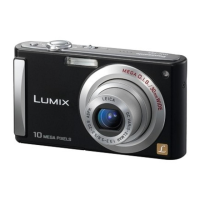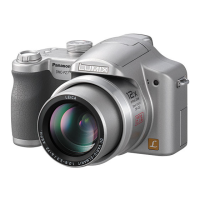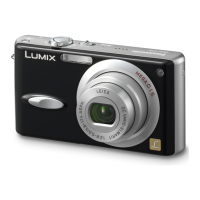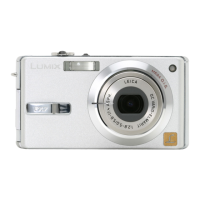26 VQT2M98 VQT2M98 27
Taking pictures with your own settings
[NORMAL PICTURE] Mode
Recording Mode:
Taking pictures with automatic settings
[INTELLIGENT AUTO] Mode (Continued)
Recording Mode:
To use flash
Select either (i Auto) or (Forced flash off).
• When is used, , (Auto/red-eye reduction),
(Slow sync./red-eye reduction) and
(Slow sync.) are selected
automatically according to the subject type and brightness. (For
details (36))
•
and indicate that digital red-eye correction is activated.
• The shutter speed is slower in
and .
In addition to automatic scene detection, [ ] in [SENSITIVITY] and backlight
compensation will operate automatically.
The following menu items may be set in [INTELLIGENT AUTO] Mode.
•
([REC] menu): [PICTURE SIZE]
1
, [BURST], [COLOR MODE]
1
• ([SETUP] menu
2
): [CLOCK SET], [WORLD TIME], [BEEP]
1
, [LANGUAGE],
[STABILIZER DEMO.]
1
Items that may be set differ from other Recording Modes.
2
Other items in the [SETUP] menu will reflect settings made in other Recording
Modes.
According to the following conditions, different scene types may be determined for the
same subject.
Face contrast, conditions of subject (size, distance, coloring, contrast, movement),
zoom ratio, sunset, sunrise, low brightness, jitter
If desired scene type is not selected, we recommend manually selecting the appropriate
Recording Mode. (Scene Mode: (40))
Backlight compensation
Backlight refers to the light that shines from behind the subject. When this occurs, the
subject appears darker, and so backlighting is automatically corrected by increasing the
brightness of the entire image.
We recommend using a tripod and the self-timer with [i NIGHT SCENERY] and
[i NIGHT PORTRAIT].
When jitter is small (e.g. using tripod) with [i NIGHT SCENERY], shutter speed can
reach a maximum of 8 seconds. Do not move the camera.
The settings for the following functions are fixed.
• [AUTO REVIEW]: [2 SEC.] • [AUTO POWER OFF]: [5 MIN.]
• [WHITE BALANCE]: [AWB] • [STABILIZER]: [AUTO]
• [AF MODE]:
(Face Detection)
3
• [AF ASSIST LAMP]: [ON]
3
(9-area-focusing) when face cannot be recognized
The following functions cannot be used.
[EXPOSURE], [DIGITAL ZOOM]
To use zoom
(29)
To use flash
(35)
To adjust picture brightness
(39)
To take close-up pictures
(37)
To adjust coloring
(55)
If a warning is displayed about jitter, use
[STABILIZER], a tripod, or [SELFTIMER].
If aperture value or shutter speed is displayed in red,
correct exposure has not been achieved. Use flash or
change [SENSITIVITY] settings.
Aperture value Shutter speed
Jitter alert
display
Using [REC] menu to change settings and set up your own recording environment.
Shutter button
Open the lens cover
The power is turned on.
Display the screen for Recording
Mode selection
Select [NORMAL PICTURE] Mode
Take a picture
Press halfway
(press lightly to focus)
Press fully
(press the button all
the way to record)
Focus display
(when focus aligned:
flashing illuminated)
AF area
(aligns focus with subject;
when complete: red green)
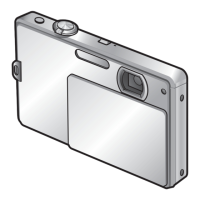
